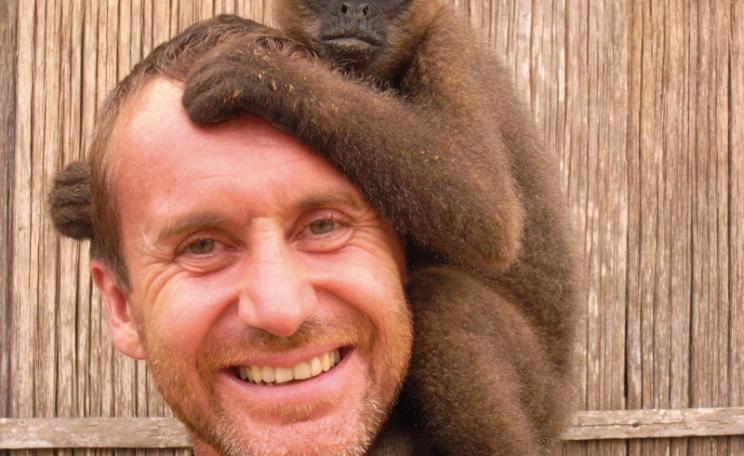Back in the late 1980s, when alternative comedy had been declared the new black, the successor to rock ’n’ roll, you could barely go anywhere in London without catching a bit of standup. Pubs, clubs, wherever you went, if the day ended in a ‘y’ it turned into Comedy Nite. Some of it was pretty funny, too, although I could barely remember most of the gags the very next morning, let alone a decade and a half later.
One routine, however, did stick in my mind. Back then, conservation was largely centred on the struggle for survival of large and familiar animals, and someone had worked out that across the plains, deserts and forests of Africa, where once millions of elephants roamed only a fraction now survived. One comedian – I forget who he was – picked up on this.
‘So, only 600,000 elephants remain. You’re reading about it in all the papers. Everyone agrees it’s terrible. But I’m not so sure. It’s that word “only” that gets me. I mean, we’re talking about 600,000 elephants, here. Imagine what that looks like. Think about it. Someone shows you 600,000 elephants, what are you gonna do? Shrug and say, “is that all you got?” Now, 600,000 ants, that would look pathetic. Probably wouldn’t even fill a bucket. Something to worry about. But 600,000 elephants? Where do they put them all?’
Big laughs all round, and a good thing, too. Comedians don’t bother finding humour in subjects that people don’t take seriously. If the plight of the elephants was fair game for comedians, then someone out there was taking the matter very seriously indeed. Conservation on a global, public scale was beginning to find its roots. But this is not why I remember that night. I remember it because the comedian had a good point. ‘600,000 elephants. Imagine what that looks like.’ I did, and I’ve still got that image in my mind to this day. What a glorious sight it would be.
There’s something about the massing in vast numbers of one species that provides an incomparable thrill. The TV wildlife presenter Chris Packham once went to Nakuru, one of the soda lakes in Kenya’s Rift Valley, to film flamingos. His equipment still packed away while he tried to work out the best shot, he looked out across the heat haze to where the birds stood secure in the knowledge that the acidic content of the lake, about ph10, kept them safe from predators. There were millions of them, creating a pink, clattering, shimmering band from west to east that occasionally exploded in places as pockets of them took off, individuals once more in flight, only to return and settle again and be reabsorbed into the packed, anonymous mass. Awe-struck by the sight, Packham left his camera where it was, pulled up a stool, and spent the next two hours simply watching the flamingos. His film remained unused.
He’s not alone in his fascination with massed creatures. Every year, tens of thousands of tourists visit Punta Tombo, a 10-mile stretch of Argentinean coastline, to watch more than half a million Magellanic penguins pitch up for the breeding season; the massive migration of more than a million wildebeest is still one of East Africa’s biggest draws; closer to home, the gannets of Scotland’s Bass Rock provide an impression of a summer covering of snow for the many tourists who visit it every year; and in his book The Snow Geese William Fiennes perfectly summed up the experience of seeing thousands upon thousands of that type of bird suddenly take off when he wrote, ‘for a moment, I had forgotten to breathe’. To explain why this type of massing has such a strong effect on us, even among the most experienced of nature-watchers, requires an understanding of why and how it happens in the first place.
The phenomenon is actually fairly rare in nature. Although many species gather in reasonably large numbers, only a comparative few congregate in their tens or hundreds of thousands, even millions. And they do so for different reasons.
For some species, mass aggregations are merely the peak of a fl uctuating population cycle that keeps a balance between their own needs and those of their predators. The lemmings of Greenland and Scandinavia follow a four-year cycle of boom and bust so extreme that their population can in one year multiply by a factor of more than 1,000. Numbering around 250 individuals per hectare at their peak, they can cover the tundra like a furry carpet, before disappearing the following year to begin the cycle anew. And right behind them, following a similar fouryear peak and trough pattern, pad their predators: stoats and arctic foxes, whose own populations rise and fall one year in arrears. It’s a neatly choreographed ecological population chase that is so much more elegant than the myth that lemmings control their own numbers by committing suicide when they become too abundant. (Incidentally, this latter theory was popularised by none other than Uncle Walt, whose 1958 film White Wilderness showed lemmings apparently hurling themselves off cliffs to their doom. In reality, they were being herded by the Disney film-makers, and even then only into a river just out of shot).
For other species, however, huge numbers represent the best chance of survival under difficult circumstances. The monarch butterfly is one such creature. Famous for its epic migrations from its breeding range in New England and the
Great Lakes to Mexico, it travels in such huge numbers that if you were present when it arrives at its final destination you would not be able to see the sky through the clouds of whirring wings. There, among the conifers of the Sierra Madre forests, the butterflies congregate on trees in their many millions, hanging like frilled clusters of black and orange leaves from branches which bend and groan under their weight, overlapping each other on trunks so not a bare patch of bark can be seen, and settling themselves for their five-month hibernation.
The monarch migrates south because it requires the warmth of Mexico to survive the winter, and north again in spring because its food-plant only grows in Canada and the north of the US. Yet why does it do so in such extraordinary numbers? On the face of it, this insect should have little to worry about: at its larval stage it feeds on the sap of milkweed, which contains a chemical that stays in the body through to adult stage and is so distasteful that birds spit it out; with only a few exceptions, most predators learn to leave the butterfly alone. The reason for the monarch’s massing lies in the struggle to survive the winter. Adult monarchs only live for about six weeks, with three generations being born and dying during the northern summer months. Only the fourth generation makes the southerly migration, where it has to settle into hibernation and outlive its forebears by more than three months, before making its way back north, laying its eggs, and finally dying where it came from. Only a tiny handful actually manage the return journey. The tightness with which they pack during hibernation helps them survive when the cold snap hits in Mexico.
For other creatures being tightly packed can turn them into a help-yourself buffet that no self-respecting predator could possibly resist. Off South Africa’s east coast, where the mighty Mozambique current whips down from the Indian Ocean towards the Cape of Good Hope, a remarkable sight plays out every year: it starts in May as a collection of monstrous bodies assemble in the warming waters off the southern tip of the continent, and begin to make their slow, leviathan way north to the cooler waters vacated by the current. At times reaching 15 kilometres in size, these mighty masses appear from above to be the true behemoths of the sea – until you look closer.
They are, in fact, shoals of millions upon millions of sardines, migrating to more nutrient-rich waters, and running the fatal gauntlet of easy predation in the process. Thousands upon thousands of sharks, dolphins and seals make their way to the region for the sardine run to feast as at no other time. The feeding frenzy is extraordinary, and has led to some intriguing behaviour. Dolphins, for example, have developed a method of dividing great pockets of the sardines into smaller groups which they herd towards the surface, surround and then pounce upon. Some shark species have noticed this and follow the dolphins to steal from their table. All in all, the sardines appear to stand no chance against the massed ranks of teeth, but their initial numbers are so great that a healthy number do get through. Although their uncountable weight of numbers is what attracts the predators in the first place, the species still stands a better chance of survival than if individuals undertook the journey alone. One fish is not guaranteed to make it: a percentage of a huge shoal is.
Understandably, such an extraordinary event draws big crowds of humans, too, and not just to fish but to watch. Yet you don’t need to travel to exotic regions to see exceptional massed sights: there’s a good chance there’s one happening just down the road.
Starlings have suffered something of a population decline in recent years, but they’re still one of Britain’s commonest birds, particularly during the winter months, when their numbers are augmented by migrants from Scandinavia. During the early dusk of this time of year they gather in great roosts, which in some places in the south number more than a million. But before they settle down for the night, they embark on a tightly packed aerial display that twists, funnels, swoops and billows like a flamenco dancer’s whirling skirt. It’s a truly uplifting sight, the birds wheeling together as if for the sheer fun of it, as they advertise their presence to each other in preparation for the communal roost, and confuse predators at the same time. As you watch this aerial dance, you find yourself wondering how they, and other flocking birds, swarming insects and shoaling fish, pull it off without bumping into each other. You’re not the first to do so.
In the 1980s, a young student named Craig Reynolds was trying to find the answer to this question that had perplexed zoologists through the ages. ‘The motion of a flock of birds,’ he wrote, ‘is simple in concept yet is so visually complex it seems randomly arrayed and yet is magnificently synchronous. Perhaps most puzzling is the strong impression of intentional centralised control. Yet all evidence indicates that flock motion must be merely the aggregate result of the actions of individual animals, each acting solely on the basis of its local perception of the world.’ He eventually came up with a theory that flocking required the observance of three essential steering behaviours for each individual: separation (steering to avoid crowding local flockmates), alignment (steering towards the average direction of local flockmates), and cohesion (steering towards the average position of local flockmates). In other words, each individual takes its compass from its immediate neighbours, and as long as every member of a flocking group follows the three basic rules, the whole will move as one without collapsing into itself.
Reynolds demonstrated his theory by applying these rules to the attributes of collective units, or ‘boids’, in a computer programme. Each boid was allowed to skate around the computer screen in a random pattern, as long as it followed the three rules. The result looked so much like a whirling flock of birds that the three rules became a new bedrock of understanding of how massed creatures move together. Reynolds went on to make a lucrative career in enhanced film animation techniques, but it is his early work that helps explain our fascination with huge aggregations of species. Each individual within the group is taking its cue from its neighbours, working with them in synchronicity both for the good of themselves, and the good of the whole. Like cells in a body, they perform their own function within their own immediate environment, creating a whole that appears to move by and control itself. The whole seems greater than the sum of its parts. It’s as if the creatures transcend their own individuality, creating a new collective beast that is so awesome that any perceptions we may have of ourselves as a dominant species on this planet are challenged.
The artist Katarina Wong understands well the dual concept of personal identity and mass interdependence. She descends, as she puts it, from a long line of migrators, giving her a foothold in a variety of cultures, a background that forms the basis of much of her artwork. Her ‘Fingerprint Project’ is a series of works derived from her huge collections of friends’ fingerprints, which she casts in wax and then mounts in patterns that mimic animalistic flocks and swarms. ‘What we experience as reality,’ she explains ‘is really a co-creative experience depending entirely on everyone and everything’s constant participation.’
Not everyone sees such beauty in animal massing, however. The swarms of desert locusts that ravaged several parts of western, northern and even eastern Africa last year were the worst seen for many years. The locusts are currently settled into their breeding season, but come June they’ll be back, and many believe they could wreak even greater havoc this year, perhaps even reaching as far east as Pakistan. Mankind, understandably, is trying to fight back, and research is being conducted into why this rather shy and unaggressive creature, which normally prefers a solitary state, can suddenly mass in its many millions and become a manic glutton. A recent discovery suggests that locust have touch-sensitive hairs on the backs of their legs which trigger the lust for swarming. If, as is conjectured, it is crop density that stimulates these hairs, then perhaps new agricultural procedures, such as revised planting techniques, could help eliminate the problem.
Of course, for now, pesticides are the preferred solution to the locust blight, and there aren’t many people who object to this: locusts, after all, are not particularly cuddly creatures. The same cannot be said of the red-billed quelea, a cute little African weaver that masses in its millions (it is probably the commonest bird in the world) and provides one of the greatest avian spectacles on the planet. Unless, that is, you’re a cereal farmer.
Agriculturalists have tried pretty much everything to disperse this destructive little seed-eater, and I do mean ‘everything’. Shooting makes little difference; poison fares little better; and some of the more desperate attempts have included napalm, and even dynamiting the trees where the birds roost. But the red-billed quelea is so plentiful that it keeps coming back. It would appear that if creatures can mass in numbers large enough, nothing can stop them.
But appearances can deceive, as this final tale demonstrates. In 1813 the US ornithologist John James Audubon was returning to his Ohio River home. It was so dark that the sun appeared to be in eclipse, but when he looked up it was no moon that was blocking the sun’s light, but a seemingly endless cloud of birds. He watched them for some time, and calculated that every three hours more than 1 billion birds passed overhead. The sound of their wingbeats was like thunder, and as they called it was like hearing millions of sleigh-bells ringing in the sky.
The passenger pigeon was so plentiful in 19th century America that it totalled a staggering 40 per cent of the country’s entire bird population. Pigeon hunting became big business, and thousands of men would telegraph each other across the land to find out where the huge flocks were turning up next. So great and persistent was the onslaught upon them that as the century closed, the pigeons were on their last legs. Their billions had been reduced to just 250,000. In 1896 this last flock settled to breed in the forest near Ohio’s Green River. The hunters were waiting for them. They bagged 240,000 and loaded them onto a train to sell back east. A few miles down the track, the train derailed. No one could be bothered to collect the birds, and the final flock of passenger pigeons, possibly the most abundant bird ever to have lived, was left to rot by the side of a railway track.
Try making a joke out of that.
Malcolm Tait’s new book The Birdwatcher’s Companion is published by Robson Books
Our cast of thousands: where are they now?
The population of the Magellanic penguin has fallen by 35 per cent in the last decade, thanks to a combination of frequent oil slicks off the Patagonian coast, and excessive fishing.
The monarch butterfly is under severe threat from illegal logging activities in the central Mexican forests where they hibernate. Mexico, in turn, is blaming the US, where modern agricultural practices are reducing the quantity of the insect’s food-plant. According to the Mexican Environment Department, 75 per cent fewer monarchs arrived to hibernate in 2004.
Britain’s breeding starlings have declined in numbers by up to 49 per cent in the last quarter-century. The probable reason is the reduction of the country’s permanent pasture, the birds’ main feeding habitat.
The last wild passenger pigeon was shot in 1900. A few lived on in captivity, the last, known as Martha, dying in 1914.
Thanks to the 1989 CITES global ivory ban, elephants are holding on, their population still estimated to be a little over the 600,000 mark. In 1997, however, a few African countries were allowed to resurrect ‘restricted’ trade, and last year Namibia was added to that list. In recent years several countries have begun once more to report poaching activities.
This article first appeared in the Ecologist April 2005







